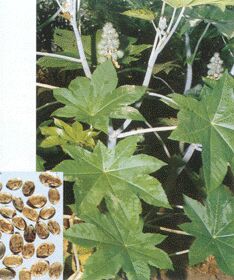
castor oil
First, the product description:
Castor oil is obtained from the seeds of ramie (about 50% oil). The oil content of the seed kernels after shelling is as high as nearly 70%, and the protein content is about 18%. Castor oil is the only commercial oil that contains mainly hydroxylic acid. The main producing areas of ramie are Brazil, India and the former Soviet Union, and all the provinces in China are planted.
Castor oil contains a large amount of ricinoleic acid (more than 80%), so it has many unique properties:
1. Easily soluble in ethanol, it is difficult to dissolve in petroleum ether. The presence of this characteristic makes it easier to distinguish castor oil from other oils.
2. Viscosity is much higher than that of normal oils, 680CPS at 25 o'clock, viscosity index 84, and low coefficient of friction (0.1).
At the same time, castor oil is insoluble in gasoline, its freezing point is low, and its ignition point is high. Castor oil has good fluidity. Refined castor oil can still flow at -22, and -50 is no cloudiness after quenching. It is an ideal lubricant for lubricating oil and power belts in aviation and high-speed machinery.
3. It is highly optically active because its asymmetric carbon atom in the main fatty acid ricinoleic acid is after the 12th position.
4. The dielectric constant is about 4.30, which is the highest among common greases.
5. The relative density and acetyl value of castor oil are greater than those of ordinary oils.
6. Castor oil has almost no oxidative rancidity in air, and has good storage stability. It is a typical non-dry liquid oil.
The physical and chemical constants of castor oil:
Relative density (d20°C4°C) 0.9550-0.9700
Refractive index (n20°CD) 1.4765-1.4819
Viscosity (E020°C) greater than 14
Freezing point (°C)18
Flash point (°C)322
Iodine value (g iodine/100g oil) 82-86
Saponification value (mgKOH/g oil) 176-187
Thiocyanate 81-82
Total fatty acid content (%) about 96
Average molecular weight of fatty acids 290-300
Fatty acid composition of castor oil (%):
Stearic acid 0.5-3.0
Dihydroxystearic acid 0.6-2.0
Oleic acid 3-9
Linoleic acid 2.0-3.5
Castor acid 80-88
Castor oil is not edible. High economic value, it is a medicinal laxative; textile, chemical and light industry and other departments use castor oil as a dyestuff agent, lubricant, plastic injection, emulsification punishment and manufacturing paints, paints, soaps and ink raw materials.
Castor oil is treated with concentrated sulfuric acid to give a surface active sulfate ester (commonly known as Turkish red oil). Castor oil dehydration gives dry fats with conjugated double bonds. Treatment of castor oil with different hydrogenation conditions can give a variety of products, so castor oil is widely used in various industrial sectors. Castor oil is the closest to the pure compound monoglyceride. In common fats, only olive oil (containing about 80% of oleic acid), safflower oil (more than 70% of linoleic acid) and tung oil (about 85% of eleostearic acid) ) This feature.
The unsaponifiable content of castor oil is less than 1%. The vitamin content is low (around 0.05).
Castor oil has high oil content. Because of the different uses of oil, the method of oil extraction is also different. The medicinal castor oil is cold-pressed with a hydraulic press and the temperature does not exceed 50, otherwise some of the impurities will dissolve into the oil and cannot be used for medicinal purposes. The oil obtained by cold pressing is called No. 1 castor oil. The cake is crushed and then pressed or leached again to obtain No. 3 castor oil (No. 2) for industrial use. The castor oil obtained by direct pressing with a screw press or using pre-press-leaching can only be used as an industrial oil.
Castor seeds
First, the product description:
The castor bean is an annual euphorbiaceae, a genus of Urtica. Also known as hemp seeds. Originated in Egypt, Ethiopia and India, and later transplanted to Brazil, Thailand, Argentina, the United States. The castor system cultivated in China was introduced from India and has a history of about 1400 years. The largest producer of castor bean is Brazil, followed by India, China and Thailand.
There is no clear distinction in the distribution of ramie in China. From Hainan Island in the south to Heilongjiang Province in the north, the Yellow River and the Yangtze River have the most extensive distribution.
Nettles like to grow in warm conditions, early spring low temperature easy to freeze seedlings or plants, in the growing season, if the temperature is low, will delay flowering maturity, and reduce the yield and seed oil content. Therefore, when you plant in the north, you must pay attention to the season.
Castor seeds
Generally, stem color can be divided into red stem type